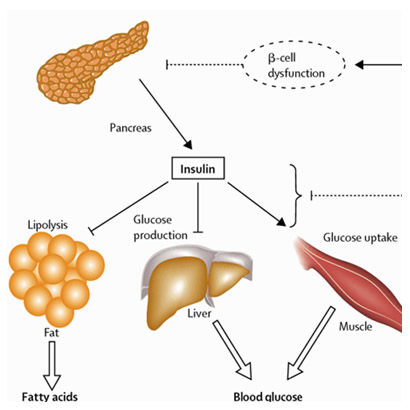Hormones – Insulin

What is Insulin
The main “Job” of insulin is to regulate how much glucose is in the blood. The amount of insulin released is related to the amount of glucose in your blood essentially meaning, the More Glucose in blood = Larger the insulin spike. It is called the Storage hormone for a reason. Glucose is transported by means of blood and taken into cells to be converted into energy. Insulin, produced by the pancreas gland, plays has an important task as it controls the uptake of glucose by your cells. After replenishing through insulin, if you have any surplus glucose, it will be converted into glycogen. When glucose is converted into glycogen, it’s stored in the liver or in the form of fat around the body. The degree to which insulin stores as fat or glycogen (Glycogen is storage tank for glucose) is dependent on the individual’s body state. If the individual has a Full tank (glycogen storage is full) then that means excess glucose will be stored as
body fat. If the tank has some room, and not full, glucose will be stored as glycogen in muscle or liver. As long as glycogen stores have room for more glucose, it has no choice but to be stored as glycogen. One way to ensure you have some room in those tanks is to weight train, as Weight training depletes the muscles of glycogen (for energy of course).
What High Levels of Insulin Means
A high insulin level is considered an appetite stimulant which can be caused by eating excessive carbohydrates/calories. When insulin levels rise it increases the release of Lipoprotein lipase (LPL). This LPL prevents fat cells from being broken down and used as fuel which means fat cells are sealed off from being used for energy. When insulin is stimulated when the individual is not working out, this will cause the conversion of carbohydrates into fat. Now, if the individual stimulates insulin and is working out, it will help synthesize muscle proteins and muscle glycogen at a very rapid rate, and very little fat will be stored. It is important to note that after a workout, when insulin is stimulated, the catabolic state turns to an anabolic state. Have that release of insulin with some additional protein for a greater synthesis of new protein!
The Good – Below are the Beneficial Sides of Insulin
-
Increases protein synthesis
-
Stimulates DNA and RNA increasing the enzymes responsible for protein synthesis
-
Increases Amino Acid Transport
-
Helps drive aminos into the muscle cells.
-
Aminos are the building blocks of proteins and muscle cells need to be saturated with aminos to drive protein synthesis.
-
-
Reduces Protein Degradation
-
Usually with Exercise there is an overall net protein loss.
-
Insulin suppresses protein degradation thus increasing a net protein gain.
-
-
-
Increases Muscle glycogen storage
-
This is good for After resistance training your muscles are depleted of glycogen.
-
-
Insulin increases the activity of glycogen synthase that converts glucose into glycogen
-
Suppresses Cortisol
-
Increases Skeletal blood flow to worked muscles
-
This Increased blood flow will help remove wastes (lactic acid/CO2) and increase the delivery of much needed nutrients.
-
This is done through Nitric Oxide synthesis as it is a strong stimulator of the Nitric Oxide pathway.
-
Insulin Resistance
Insulin Resistance is a condition that dramatically slows muscle glycogen recovery, repair of existing muscle, and synthesis of new muscle. The longer you stay in a catabolic state the more you develop insulin resistance (usually occurs about 2-4 hrs after activity).
Ways to Prevent Insulin Resistance
-
Weight training adds muscle tissue
-
Adding muscle tissue will cause the receptor to become more insulin friendly.
-
When muscle receptors are more receptive this will make insulin receptors on fat cells resistant as they are not used to the process of taking in glucose.
-
The more friendly the muscle cell is to insulin the less of an insulin spike.
-
Insulin receptors are highly excitable after training so this increases the chances that carbs pwo will be stored as glycogen.
-
-
Omega-3s protect against the damage to muscle cells caused by some Saturated fat.
-
They actually help thin the blood and upgrade insulin sensitivity.
-
Sources include – Salmon, trout, sardines, herring, mackerel.
-
-
Fiber
-
Slows down the digestion of glucose = less insulin secretion.
-
Insoluble fiber increases insulin sensitivity in muscle cells.
-
-
Chromium
-
Participates in the utilization of glucose.
-
Helps reverse insulin resistance.
-
About the Author Vinny Russo
I have a Bachelors in Science, I am PN.1 certified, NFPT certified, and in the process of obtaining my CN.L (Clinical Nutritional License) and my MSCN (Masters in Applied Clinical Nutrition). My mission is help you reach your health-related goals while educating throughout our journey together. The goal is to have you become a master of your own health by teaching you how nutrition works and what works best for your individual body.
Session expired
Please log in again. The login page will open in a new tab. After logging in you can close it and return to this page.
